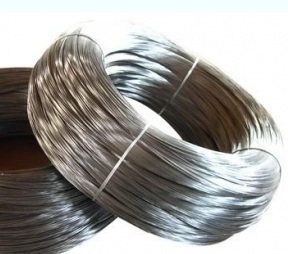Alumel

Alumel NMtsAK2-2-1
Alumel NMtsAK2-2-1 used as compensating cables in pyrometry as a negative electrode of chromel-alumel thermocouple. Thermocouple Chromel – alumel has a high thermal emf and is used to measure temperatures up to 1000 ° C.
The chemical composition of alumel NMtsAK-2-2-1 in accordance with GOST 492-73
|
alloy grade |
А1 |
Si |
Мп |
Со |
Ni |
|
Alumel NMtsAK 2-2-1 |
1,60-2,40 |
0,85-1,50 |
1,80-2,70 |
0,60-1,20 |
East. |
|
alloy grade |
Impurities,%, no more than |
application |
|||||||||
|
Fe |
Mg |
Сu |
Рb |
S |
C |
P |
Bi |
As |
Total |
||
|
Alumel NMtsAK 2-2-1 |
0,30 |
0,05 |
0,25 |
0,002 |
0,01 |
0,10 |
0,005 |
0,002 |
0,002 Sb 0,002 |
0,70 |
Thermocouple Wire |
Physical and mechanical properties alumel NMtsAK2-2-1
Melting point, ° C 1430-1450
Density, g / cc 8.5
The electrical resistivity, Ohm ∙ mm2 / m 0.25-0.35
The temperature coefficient of resistivity, 0,0027-0,00044
The tensile strength Rm kgf / mm 2: 56 soft
The tensile strength Rm kgf / mm2: hard (hardening 80%) 110
Elongation δ,%: 36 soft
Elongation δ,%: solid (hardening 80%) 2
Hardness HB kgf / mm2: 130 soft
Hardness HB kgf / mm2: solid 250-300
The magnetic properties of the magnet
Technological properties and modes of processing alumel NMtsAK2-2-1
Temperature, ° C: Casting 1480-1500
Temperature, ° C: Hot processing 1180-1220
Temperature, ° C: The annealing 900-1000
Maximum operating temperature, ° C 1000
Etchant N2CO4: HNO3 1: 1
The temperature of the mold, ≤100 ° C
Grease – kerosene: Dutch black 9 1
Flux Glass
Alumel the values of thermal emf divided into four classes. It is used in tandem with chromel corresponding class.
The thermoelectric power (mV) alumel alloy wire paired with a pure platinum at the free end of the 0 ° C in accordance with GOST 1790-63
|
The temperature of the working end, ° C |
class |
|||
|
I |
II |
Ш |
IV |
|
|
100 |
1,20—1,36 |
1,18—1,34 |
1,16—1,32 |
1,14—1,30 |
|
200 |
2,09—2,25 |
2,04—2,20 |
1,99—2,15 |
1,94—2,10 |
|
300 |
2,81—2,97 |
2,74—2,90 |
2,67—2,83 |
2,60—2,76 |
|
400 |
3,56—3,74 |
3,46—3,64 |
3,36—3,54 |
3,26—3,44 |
|
500 |
4,37—4,57 |
4,25—4,45 |
4,13—4,33 |
4,01—4,21 |
|
600 |
5,22—5,44 |
5,08—5,30 |
4,94—5,16 |
4,80—5,02 |
|
700 |
6,11—6,35 |
5,96—6,20 |
5,81—6,05 |
5,66—5,90 |
|
800 |
7,01—7,27 |
6,85—7,11 |
6,69—6,95 |
6,53—6,79 |
|
900 |
7,88—8,16 |
7,71—7,99 |
7,54—7,82 |
7,37—7,65 |
|
1000 |
8,71—9,01 |
8,53—8,83 |
8,35—8,65 |
8,17—8,47 |
|
1100 |
9,50—9,82 |
9,32—9,64 |
9,14—9,46 |
8,96—9,28 |
|
1200 |
10,22—10,56 |
10,04—10,38 |
9,86—10,20 |
9,68—10,02 |
Note. In a pair of platinum alloy alumel is a negative electrode.
Mechanical and physical properties of the wire thermoelectrodes alumel thermocouples NMtsAK2-2-1 GOST 1790-63
|
The diameter of the wire |
The tensile strength Rm
kgf / mm2 |
The electrical resistivity δ,% |
The electrical resistivity,
Ohm ∙ mm2 / m |
|
no less |
|||
|
0,2; 0,3 |
45 |
20 |
0,33±0,05 |
|
0,5; 0,7; 1,2; 1,5; 3,2; 5,0 |
45 |
25 |
0,33±0,05 |
Nickel alloys with aluminum (alumel without manganese) are less convenient in practical terms, as manganese significantly increases the electrical resistance of alumel without changing the temperature coefficient of electrical resistance and making t. E. d. s. at all temperatures more positive.
Alumel thermoelectric power NMtsAK2-2-1
|
The temperature of the hot junction, ° C |
T. e. d. s. alumel paired with platinum reference junction at 0 ˚ C, mV |
Corrections for temperature alumel free ends in a pair of platinum |
|||
|
reference junction temperature, ° C |
t. e. d. s., mV |
reference junction temperature, ° C |
t. e. d. s. ° C |
||
|
0 |
0 |
20 |
0,26 |
||
|
100 |
—1,20 |
10 |
0,13 |
21 |
0,27 |
|
200 |
— 1,98 |
11 |
0,14 |
22 |
0,29 |
|
300 |
—2,68 |
12 |
0,15 |
23 |
0,30 |
|
400 |
—3,46 |
13 |
0,17 |
24 |
0,31 |
|
500 |
—4,31 |
14 |
0,18 |
25 |
0,33 |
|
600 |
—5,17 |
15 |
0,20 |
26 |
0,34 |
|
700 |
—6,03 |
16 |
0,21 |
27 |
0,35 |
|
800 |
—6,93 |
17 |
0,22 |
28 |
0,36 |
|
900 |
—7,78 |
18 |
0,23 |
29 |
0,38 |
